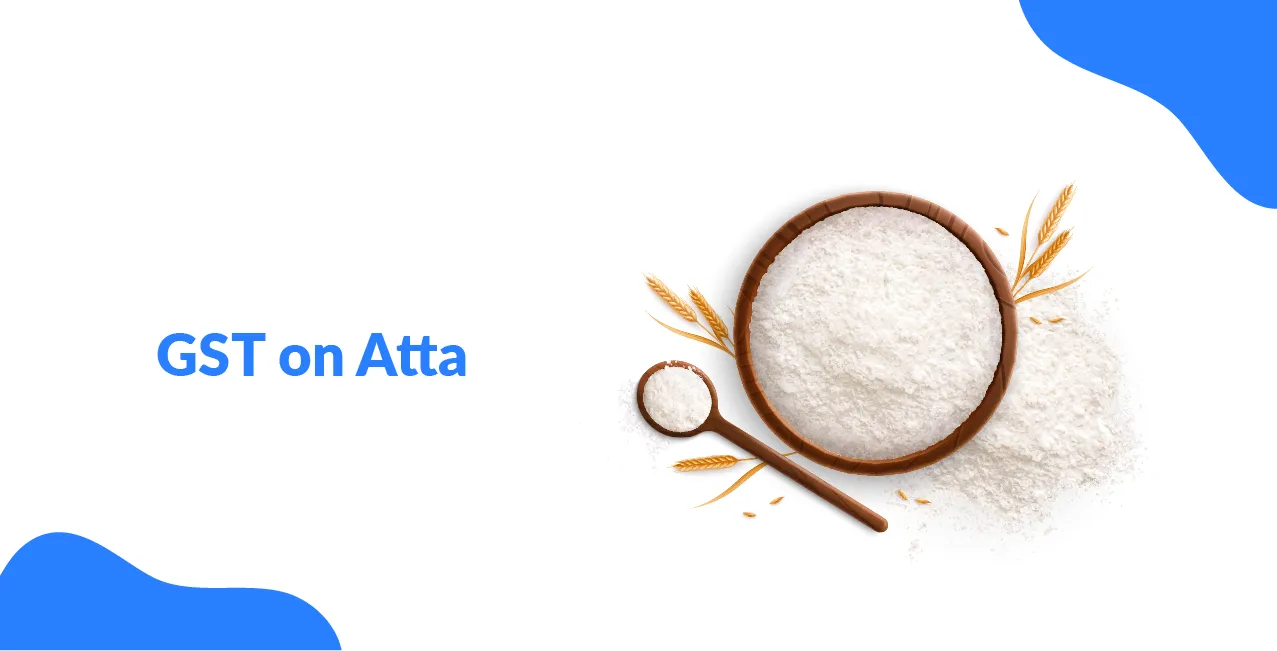
Author
LoansJagat Team
Read Time
6 Min
14 Jul 2025
GST on Atta – Why Your Daily Dough Now Costs a Bit More
Imagine you buy a 10 kilogram branded atta pack priced at ₹250. What you may not notice is that ₹11.90 of that is not for the wheat — it is Goods and Services Tax at 5 %. That means for every kilogram, you are paying around ₹1.19 just in tax.
Now picture this: ten crore Indian families each buy one 10 kilogram branded atta pack every month.
Do the math:
₹11.90 (GST per pack) × ten crore packs = ₹1,190 crore collected every single month — all from just atta.
Over one year, that becomes a massive ₹14,280 crore in tax; enough to fund entire highways, village schools, or improve national nutrition schemes.
So what does this blog bring to your thaali?
- rystal-clear numerical breakdowns – See exactly how much GST is added to your atta.
- Category-wise tax insights – Know when you are paying 5 % and when you are paying zero.
- HSN code clarity – Understand the codes that apply to different atta types.
- Smart business insights – Learn how manufacturers can claim input tax credit and reduce costs.
- Money-saving knowledge – Discover how buying loose versus packaged atta can save ₹100 to ₹500 per year.
From loose chakki flour to shiny supermarket packs, we will walk you through every corner of India’s wheat market and show how GST on Atta affects both everyday consumers and businesses alike.
“Roti ki keemat sirf gehun se nahi, GST se bhi tay hoti hai bhai!”
GST on Atta – Table of Categories, Prices, and GST
Here is a snapshot of how different types of atta are taxed and priced:
So next time you are at the grocery store, you know exactly what that ₹6 extra is doing on your bill!
Example:
Ritika, a working mother from Pune, does her monthly grocery shopping at the local supermarket. She prefers buying branded premium atta for quality assurance. She picks up a 10 kilogram pack priced at ₹230. At the billing counter, she notices that the final amount is ₹241.50, which seems odd at first.
Curious, she checks the invoice. A 5 % GST has been added to the base price.
Here is the breakdown:
- Base Price: ₹230
- GST @ 5 %: ₹230 × 0.05 = ₹11.50
- Final Price: ₹230 + ₹11.50 = ₹241.50
Now, consider this: her neighbour, Shyam, buys loose, unbranded atta from the local chakki at ₹25 per kilogram. He needs 10 kilograms as well, so he pays:
- 10 kg × ₹25 = ₹250
- GST @ 0 % = ₹0
- Final Price = ₹250
Interestingly, both end up paying nearly the same — Ritika pays ₹241.50 for a branded product, while Shyam pays ₹250 for a local, unpackaged version.
However, if Ritika had purchased five 5 kg packs of branded regular atta instead of one 10 kg pack, her total would be:
- 5 packs × ₹120 base = ₹600
- GST @ 5 % = ₹600 × 0.05 = ₹30
- Final Price = ₹600 + ₹30 = ₹630
So, by choosing a 10 kg premium pack over five 5 kg packs, Ritika saves ₹388.50 while still enjoying a high-quality branded product.
This comparison shows how pack size, branding, and GST rates can affect monthly household budgets, especially when shopping in bulk.
Read More - GST on Bread
HSN Codes for Atta – Understanding the Numbers
HSN (Harmonised System of Nomenclature) codes are used to classify products under GST.
Retailers and manufacturers use these codes while filing GST returns and generating invoices.
“Code yaad rakho bhai – bina code ke GST ka game hi nahi jamta!”
Types of Atta and Their GST Applicability
Here is a neat table showing what kind of atta gets taxed and what does not:
So essentially, the GST is not on the atta itself but on how it is presented and marketed.
Impact of GST on the Atta Industry – Real Examples
Let us look at the lives of three businesses to see how GST on atta plays out.
1. Local Chakki (Mill)
A local chakki sells atta loose and unbranded at ₹25 per kg. There is no GST on this. People buying from here save ₹1.25 (5%) compared to packaged brands.
2. Packaged Atta Brand
A company packages 5 kg branded atta at ₹120. Here, 5% GST = ₹6, so the consumer pays ₹126. This cost often gets absorbed in the final price or passed on to consumers.
3. Bulk Supplier
A wholesaler sells 30 kg branded atta to restaurants and hotels. Since the pack exceeds 25 kg, no GST applies. These suppliers often benefit from tax-exempt pricing.
Now let us look at some quick maths.
If a company sells 1000 bags of 5 kg atta per day at ₹120 each, the daily GST collection is:
1000 × ₹6 = ₹6000 per day
Over a month (30 days):
₹6000 × 30 = ₹1,80,000
So, a simple 5% GST on atta contributes lakhs in tax revenue from just one mid-sized business.
“Thoda thoda karke poora chakki chala jaata hai!”
Input Tax Credit (ITC) on Atta – A Manufacturer’s Best Friend
Manufacturers who buy wheat and packaging material pay GST on those inputs. The government lets them offset this tax paid against the tax collected on sales.
Let us see how it works.
Example:
- Wheat cost (for 10 kg): ₹100
- GST paid on wheat: ₹5
- Packaging, logistics: ₹20 + GST = ₹21
- Selling price: ₹150 + GST = ₹157.5
- GST on sale: ₹7.5
- Total ITC claimed: ₹5 (on wheat)
Net GST payable = 7.5 - 5 = ₹2.5
So the real tax paid to the government is just ₹2.5. The rest is adjusted through ITC.
This helps businesses manage costs and keeps branded atta competitive in price.
Conclusion
The GST on Atta is a classic example of how taxes are designed around usage patterns. The government aims to protect the common man by exempting unbranded, loose atta, while also ensuring that value-added, branded products contribute to the economy.
If you prefer cost over branding, go local and loose — no GST.
If you prefer convenience and packaging, be ready to shell out 5% extra.
Either way, it is important to understand how your everyday purchases are taxed.
Next time you are at the supermarket or your local grocery shop, take a second look at that price tag. Somewhere in that label, a little bit of GST is quietly doing its job.
“Ab toh samajh gaya na? Aata toh wahi hai, par bill mein farak padta hai!”
FAQs Related to GST on Atta
Q1: Is GST applicable on all atta sold in the market?
No. GST applies only to branded and packaged atta that is sold in quantities up to 25 kg.
Q2: What if I buy loose atta from a local shop?
Loose, unbranded atta is exempt from GST. You pay only the base price.
Q3: Do multigrain or organic atta packets attract GST?
Yes. As long as they are branded and pre-packed up to 25 kg, they attract 5% GST.
Q4: Can restaurants or bakeries claim input credit on atta?
Yes. Registered businesses can claim input tax credit on GST paid on branded atta used in food preparation.
Q5: Why is bulk packaged atta not taxed?
Packages above 25 kg are considered bulk and meant for industrial or institutional use. Hence, no GST applies.
Q6: Where can I check the current GST rates?
Visit the official GST portal for updates on rates, notifications, and HSN codes.
Other Important GST Pages | ||||
About the Author

LoansJagat Team
‘Simplify Finance for Everyone.’ This is the common goal of our team, as we try to explain any topic with relatable examples. From personal to business finance, managing EMIs to becoming debt-free, we do extensive research on each and every parameter, so you don’t have to. Scroll up and have a look at what 15+ years of experience in the BFSI sector looks like.

Quick Apply Loan
Subscribe Now
Related Blog Post


